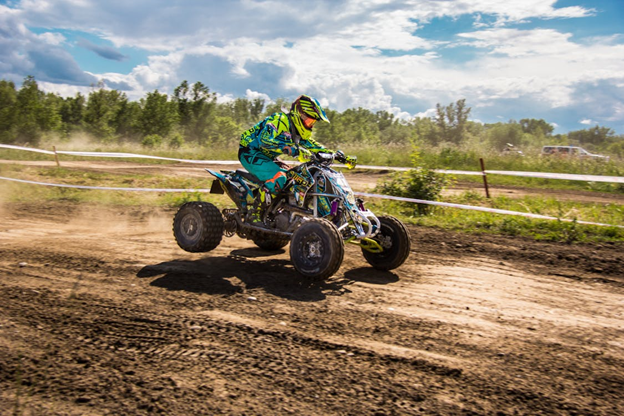At a glance
- Inspect all ATV parts, including fuel, brakes, tyres, and lights, before riding.
- Wear protective gear like helmets, gloves, and moisture-wicking clothing.
- Stay hydrated with water or sports drinks; avoid caffeine and sugary beverages.
- Ride in shaded areas and take breaks to cool down and reapply sunscreen.
- Carry essential tools, spare parts, fluids, and a first aid kit for emergencies.
- Follow safety guidelines, ride within your skill level, and take an ATV safety course.
There’s nothing quite like the thrill of ATV off-roading in the summer—the warmth of the sun on your skin, the wind rushing past, and the adrenaline rush of conquering rugged trails.
But while summer rides are exciting, they also come with their own challenges. The heat can be brutal, your ATV works twice as hard, and if you’re not careful, dehydration or a mechanical breakdown can cut your adventure short.
No one wants to be stuck miles away from help, dealing with an overheated engine, or feeling lightheaded from the sun.
That’s why a little preparation goes a long way. Before you hit the trails, let’s talk about the key things you need to consider to stay safe, protect your ATV, and make the most of your summer off-roading experience.
Check all Parts
Being stranded in the middle of off-road is the last thing you want on your trip. So, before you take your ATV on the road, always inspect all vehicle parts and save yourself from mechanical failures and accident risks.
- Make sure you have enough fuel level to avoid running out during the ride.
- See the brake fluid, oil, and coolant.
- Are the ATV tyres in good condition for off-roading? Ensure they have proper inflation. Investing in high-quality tyres can make all the difference in your ride.
- Inspect the controls and cables like brakes, throttle, steering, and other vital components.
- Test all the lights, like the headlight, taillight, and brake light, to see if they’re working properly.
Wear Protective Gear
For all ATV riders off-roading this summer, wearing protective gear is a must! The harsh sun can pose a potential risk to your health, so don’t neglect it. Start with sunscreen, you can lather yourself in it! Tinted sunscreen with UV ray protection is especially effective in preventing skin damage.
Even when it’s hot, wear full-length cotton or moisture-wicking clothes to avoid sunburn. You can choose the one that feels light, breathable, and comfortable. It’ll save you from dust, debris, potential scratches, etc.
Rollovers are the most common risks that could lead to severe injuries. So, add more protective gear like helmets, riding gloves, kneepads, goggles, boots, and riding jackets to stay safe. Off-roads are unpredictable, and you do not want to compromise your safety.
Stay Hydrated
In the scorching heat, excessive sweating can make you dehydrated and exposed to illnesses like heatstroke and heat exhaustion. Dehydration can affect your focus and slow down reaction times and endurance, making your journey very challenging. That’s to stay on top of your game during summer ATV adventures and drink plenty of water.
Or opt for the hydration packs if you want to avoid the frequent stops. You could also take sports drinks to hydrate and energize your body. But, refrain from taking diuretic drinks like caffeine, alcohol, and sugary beverages that reduce hydration.
Ride in the Shade
If possible, ride in the shaded areas to protect yourself from the direct heat and dehydration in summer. While it may sound questionable in hot summer weather, you can choose trails that pass through wooded areas with cooler air.
Also, take frequent breaks in shady places whenever you can. You do not have to ride nonstop until you’re exhausted. Take rest, cool down your heating body, reapply your sunscreen, drink some water, and then continue your journey feeling recharged.
Tools and Kits
When heading out for ATV off-roading, bring the tools and kits along with you. Here’s what you can pack to prepare you for the unexpected issues.
- Basic tool kits: Include screwdrivers, wrenches, and flashlights for common repairs.
- Tyre repair kit: Bring tyre plug kit, a Tyre patch kit, and a 12-volt air pump or CO2 inflator for fixing flats or leaks.
- Spare parts: Drive belt, Spark Plugs, Portable Jump box.
- Fluids and Filters: Pack extra Engine oil, coolant, air filter, fuel filter, and brake fluid.
- First Aid Kit: Antiseptic wipes, Bandages, Pain relievers, and basic first aid kits.
Know the Risks
We’re not trying to scare you, but it’s important to be aware of the risks! Always ride on a designated trail and choose a vehicle that matches your skill level.
Read the manual thoroughly and consider enrolling in an ATV safety course. Know your limits, and don’t push yourself too far, especially after watching one of those cool ATV off-roading videos.




